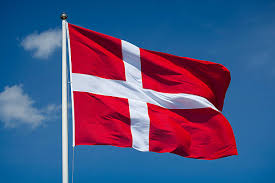Operation: Kiel
Date: 26/27th August 1944 (Saturday/Sunday)
Unit: No. 156 Squadron
Type: Lancaster III
Serial: PB302
Code: GT-B
Base: RAF Upwood, Cambridgeshire
Location: North Sea
Pilot: Fl/Lt. Robert Mather Etchells 161599 RAFVR Survived
Fl/Eng: Fl/Sgt. John Davidon Gray 1567893 RAFVR Survived
Nav: P/O. John E. Goldsmith J/85064 RCAF Survived
Air/Bmr: P/O. Allan James Campbell Croome AUS/421175 RAAF Age 21. Survived
W/Op/Air/Gnr: W/O. Evander William Cameron Hay 1330616 RAFVR Survived
Air/Gnr: Fl/Sgt. John Francis Stearn 960576 RAFVR Survived
Air/Gnr: P/O. Sidney Freeden 177404 RAFVR Survived
With many thanks to Jack Albrecht and the family of P/O. John Goldsmith. To Sid Freeden and family for allowing the reproduction of his diary of the events this day. Words retyped and presented on this page - together with the original photographs and drawings. It is important to note that the illustrated story has been written by the rear air gunner, Sidney Freeden and our thanks to Jenny Stephens, his daughter who scanned the pages for Jack. These have been marked with our logo - not that we own the copyright - no one does, except the original photographer. But placed that if others decide to use them (they only have to request permission) people know where they originate from.
Also, as a follow up, Jack submitted information on the Danish fishing vessel that rescued the crew. Not often we are able to also know about the rescuers. See the end of the page for further details.
REASON FOR LOSS:
Taking off from RAF Upwood, Cambridgeshire at 20:21 hrs. Part of a total force of 372 Lancasters and 10 Mosquitoes of Nos. 1, 3 and 8 Bomber Groups dispatched to Kiel.
Weather: fine, becoming fair.
“The Naval base at Kiel was heavily attacked by heavy bombers. Weather conditions certainly lent themselves to the attack and the marking was punctual and ample. A really good 'prang' on the 'primary' developed and some really good explosions are reported. Flak of a desultory nature did not deter the insistence of the presence of fighters were likewise treated with impunity. A severe electrical storm was encountered on the homeward leg of the raid."
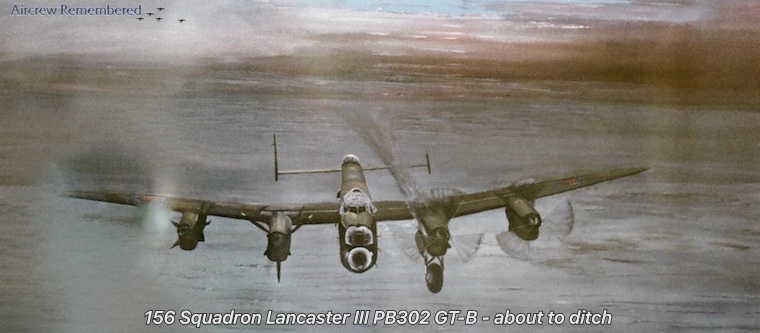
The Pathfinder marking was hampered by smoke-screens but the local report tells of a very serious raid with heavy bombing in the town centre and surrounding districts, Widespread fires fanned by a strong wind. The Rathaus was completely burnt out and many other public buildings were destroyed or seriously damaged. Some 134 people on the ground were killed with a further 1,002 suffering various degrees of injuries.
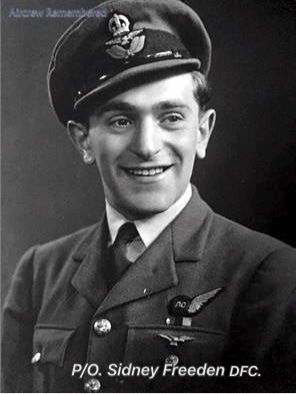
What follows is a true copy from the diary of Sid Freeden on the remarkable days events following their operation:
After briefing there was the usual rush of aircrew to messes. The operational meal was ready waiting for us, first there, first served (If you are lucky)

The meal is more or less standard on all operational squadrons - chips, egg and bacon with toast - what one does for one's country …….. and an egg!
However the meal over, everyone goes to his respective sections to get the last minute gen, the navigator to the navigational section, wireless operators to the wireless section, engineers to the engineers section and the gunners to the dressing room.

Due to the intense cold at operational heights the gunner must wear suitable clothing. He dons his long woollen and nylon underwear, pullovers, sweaters, electrically heated clothing etc and in the process you must dress slowly so as to prevent perspiring. sometimes he carries his flying clothing out to the aircraft and then gets dressed but that is optional. When ready he collects his Mai-West, harness and parachute and climbs aboard the crew bus waiting outside to take him out to his aircraft.
Johnny and myself were the first to arrive out at the aircraft so whilst waiting for the rest of the crew we took the covers off the our turrets and gave them a last minute check. Everything seemed to be in working order, A few minutes later the boys came out
We had an hour to go before take-off so Bob and Jock climbed aboard and ran up the engines. This done we passed that time away smoking and talking to the ground crew the weather didn't look too good but the met man said we didn't have much to worry about.
For no apparent reason, there was an uneasy feeling amongst the crew no one spoke his mind openly but it was as plain as day on all seven faces. Jokingly Johnny said “Ah well there is no beer in the mess tonight, so we're sure to get the chop”. Little did he know how near we were going to be to the old reaper’s scythe.
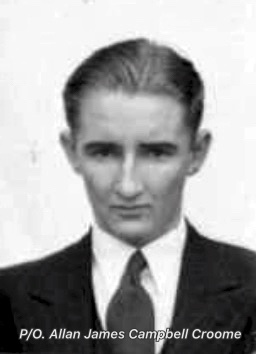
Five minutes to go, so we all prepared to climb aboard. Other kites were taxying around the perimeter track, so we started up and followed them round. It's a grand sight to see all the planes lined astern waiting to take off. Light was closing in fast and they just looked like giant birds rearing up into the night with red and green lights attached to their wing tips.
Flying control signalled us away with the green aldis lamp and simultaneously the four Merlin engines increased their purr to a gigantic law as Bob opened the throttles.
The tail rose and our speed steadily mounted until finally we were a airborne. 64,000 pounds of aircraft and grew took to the air. As we climbed on a steady course the drome gradually faded into the night, all except for the outer circle lights. We turned to Port and came back over the drome to set a course Goldie gave Bob his course to steer and soon we were heading North West and everyone got down and concentrated on his own job.
We crossed the East coast of England in darkness accompanied by the navigation lights of other aircraft blinking around us. One by one the lights went out and finally there were only the stars to be seen. It is a depressing feeling to look out of the aircraft and see nothing but black inky space. But after a spell of operational flying one gets to realise that there are hundreds of other aircraft and crews in that vast black space with you and not very far away. In fact one does not realise how near they sometimes are! It's a comforting thought to know that you have company.

The target is Kiel and a journey across the North Sea is long tiring and monotonous the time just drags and drags and drags.
My eyes were beginning to ache due to that constant searching of our stern and quarters, and I just felt like closing them I'm sleeping until we got home again. But by this time we were only a few minutes flying time away from the enemy coast, so sleeping was out of the question
Things were still quiet as a we crossed the coast, but not for long. As we flew inland searchlights appeared as if from nowhere and they were accompanied by bursts of heavy flak. Searchlights have never shot anybody down and the flak was only a barrage form fired spasmodically so there was nothing really to worry about ….. yet!
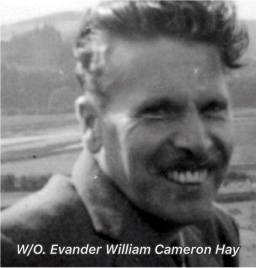
As we neared the target, naturally the tension grips one more than ever especially over this target. Kiel has always being sticky. Soon we were in the target area and dead on time the first pathfinders dropped their flares and bombs. Seconds later the whole target was lit up with flares, fires, explosions and searchlights. Night was literally turned into day and the flat grew with intensity, some bursting too close for comfort

The bomb aimer took us on a steady course with his - left - left - s-t-e-a-d-y. A beautiful bombing run. “Bomb doors open” and as Bob opened them one can feel the rush of air in the bomb bay and the, old Lanc quIvers slightly. The aiming point slid down the bomb-site line and after what seemed an eternity of straight and level flying, Junior gave us “Bombs gone”. What a relief!
He seemed to appear from nowhere and for a brief moment my heart stopped beating. His range was closing rapidly and as I switched on my intercom and informed Bob “fighter fighter” “corkscrew port - go”. The fighter opened fire, I pressed my triggers as well. I could see his white tracers coming straight towards me and almost instantaneously there was a blinding flash and a terrific explosion. We had been hit and any moment I expected the old Lancaster to fall apart in mid air.
I kept my fingers depressed on the triggers all the time firing a long steady burst. As we went into our invasive action the fighter broke away to our starboard quarter and as he banked over an explosion took place between his port engine and fuselage. At that moment my guns stop firing and I knew then that the hydraulic system had been severed. But it wasn't to soon. The fighter overturned on it's back and plunged into an uncontrollable spin with black smoke belching from it.

As always bob asked if everyone was alright and miraculously enough, they were. The whole front of my turret was stoved in and my right leg was jammed in between the front of the turret and the control column. It went numb but in a little while I was able to assure myself that my leg was still in one piece. Bill and Goldie felt what they thought was a canon shell pass between their legs. How lucky they were to.
As best we could, we tried to assess the damage to the aircraft. Visual evidence showed the port elevator was shot clean off, the fuselage was seriously holed, two holes being about 2 feet in diameter, the starboard propeller on the outer engine was shot off, the two inner engines were on fire and the whole hydraulic system was shot away
Our flares were retained as it was only necessary to drop the bombs and these had to be jettisoned, This we did, but could not close the bomb doors again. The flaps were also unserviceable.
A quick decision had to be made. Sweden was near but not near enough. Base was also too far away two alternatives were left. Either to bail out or to try a forced landing in the sea. The latter was decided upon. Bob just said “well I'm sorry fellows, but I guess we’ll have two ditch the old girl”. Everybody acknowledged.

To come down on the water with the fuselage like a colander, bomb doors open and no flaps was asking for a lot. In the meantime the port wheel came down and could not be retracted. The odds were against us, but at least we would all be together
We were losing height rapidly and with the help of the one good engine we managed to make a good 40 miles from the enemy Coast.

Ditching stations were taken up at about 8000 feet and the next few minutes past like years. Each member of the crew was laid in his appropriate position in the fuselage with his hands clasped behind his head and his feet braced against the structure so as to absorb the impact of the landing. The descent of the aircraft was relayed in hundreds of feet for man-to-man right down the fuselage, and when Jock signalled 500 feet my heart beat 10 times faster. Everybody had the same thing in mind. It was written all over our faces would Bob be able to make it. The odds against us was so heavy. My body was braced rigidly against the side of the aircraft and I just waited. They were agonising seconds. There was a terrific thumping going on inside my chest and I began to shake little. The thoughts that ran through my mind were almost beyond human imagination. They were the thoughts of a condemned man. Then that terrifying tension gripped me again as I felt the plane levelling out for its last landing. Bob was doing his utmost and I had full confidence in him. More than ever now. And then what we were waiting for for so long, came.
'CRASH'. She hit the water at 140 mph and came to a standstill almost immediately. The nose went under and then slowly came up again. At the same time, the whole tail unit tore away and there she swayed with her broken body rising up at an angle of 45°
Before any of us could regain our feet, there was wild onrush of water the whole length of the fuselage, and for a brief moment, I lost hope. I was completely submerged. Salt water was in my nose, mouth and lungs. Water was everywhere
Instinctively I grabbed something and pulled myself to my feet and I fought my way up to the escape patch. I found the dingy manual release and pulled it with all my might, but the automatic release had functioned perfectly

It was really an effort to climb up the wire ladder up to the hatch, but with the help of Johnny behind me, I was able to manage it.
There was no panic and no fuss. Each man quietly waiting his turn to get out in the men behind helped the man in front of him, Teamwork is a wonderful thing
Within a matter of seconds we were all out of the fuselage and onto the wing, and The quick-roll call revealed all to be safe and present. The dingy was already out of it storage and fully inflated. Jock cut the moorings and launched it. One by one we climbed aboard, and then as if pulled by some invisible force the dingy drifted away from the aircraft and left Johnny and myself stood on the wing. The aircraft was slowly settling, so we decided to jump for it. Johnny made one wild leap and hit the water with a big splash, but he managed to grab the side of the dingy. As he jumped the tail rose vertically in the air and I Iost my balance and slipped down the wing. I grabbed the trailing edge of the wing and was able to haul myself back again, and then I jumped. A few strokes brought me to the side of the dinghy and we withdrew to avoid the suction made by the final plunge of the old lady. Johnny and I were still in water clinging on to the dingy, and we both kicked out as hard as our flying clothing would permit us to. The boys in the dingy paddled away even using there bare hands.
Nobody spoke as we saw the fuselage slide slowly down, and a few seconds later there was nothing to be seen but a few bubbles on the surface.
None of us had been in love with this Kite. Our own “B” was written off by another crew a couple of weeks previously and ever since this one was given to us, something has always gone haywire. But when we saw her going down, we couldn't help but have a certain feeling of sentiment to the old girl.
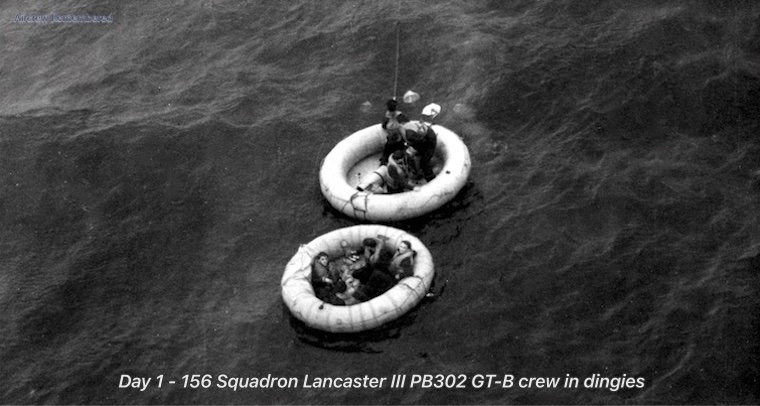
The sea was dead calm. That was Gods will and surprisingly enough it was quite warm too.
With a bit of difficulty, Johnny and I were hauled aboard the dingy by willing hands. We looked sorrowful sights - just like a couple of wet sponges.
We held an inventory, and at and we had the dingy pack full of water, signal cartridges, a verey pistol, and a couple of flouroscene blocks, one of which was put to immediate use. We also had our Mae-Wests and a few torches. The dingy radio was washed out of the fuselage when we hit the water and it wasn’t encouraging to hear that Bill could not send an SOS because the trailing aerial was shot off. Still, there is always hope. The time was 12:25 hrs.
We made ourselves as comfortable as possible with our legs outstretched towards the centre of the dingy, and everyone felt quite confident that it would only be a matter of time before we would be picked up.
A couple of hours later, we found that it was no longer possible to stretch our legs right out. That only meant one thing - the dingy was leaking! So we all started to search for the puncture. Junior found one and with the help of the puncture outfit equipped in the dingy, he was able to repair it.
That helped a little, but somewhere there was another hole, but it could not be located. Our spirits dropped when we found that there was no pump with which to top up the buoyancy chamber. In order to prevent any further punctures, all knives, helmets and other contrivances were thrown overboard. A hole in the floor was plugged up with one of those plugs provided and the water was baled out with anything we could find. I used my dress cap which had caused me considerable trouble getting it out of the aircraft, and now I had to use it to bale out water! The dingy pack was opened and we rationed out the cans of water and anergy tablets. The Verey pistol was taken out together with a tin of cartridges and laid on one side at the ready. The we just sat and waited.

The conversation was cheerful but we grew tired of talking. Each one of us had his own individual thoughts and I dont think they differed very much. We prayed too.
I looked over the side into the water and passed some time away staring at the phosphorescent effects. Flak was still bursting over the enemy coast.
At 06:00 hrs on the Sunday morning, we heard the sound of aero engines. Must be the planes coming back from the long Konigsberg raid. I put a rocket in the pistol and waited for the sound to get nearer. As it passed almost overhead, I fired off the distress signal and the bright red rocket shot up into the night and slowly cascaded down again reflecting its brilliant red glow on the water. It really was beautiful to see. All heads were raised, eyes searching hopefully, but nothing happened, I fired another signal off and we waited again. The sound of the engines grew near and faded away several times. That could only mean one thing. He was searching for us. I fired another rocket and tis time he acknowledged it by flashing “OK” on his downward identification light. We all screamed our heads off with joy. What a sensation! “Oh, we’re sure to be picked up by morning". Bob remarked, and we all agreed.
Fifteen minutes later another aircraft passed overhead and just to make doubly use I fired off another rocket. This he acknowledged by firing off a white verey light. Boy, did we feel good now!
Dawn was just breaking and we were able to distinguish the aircraft as another Lancaster as he passed over us.
Then dawn did break, we were all wide awake and full of hope and confidence. Nobody felt like eating, but we all had two swallows of water each. The arrangement we had decided upon was to ration each man with that amount of water and two Horlicks tablets per meal. Meals being three times a day. That was just in case …..
It was a dull morning. There was an overcast of cloud and quite a strong breeze blew up. The sea was not calm any more. Bob went a bit off colour and took his teeth out, leaned over the side of the dingy and showed old father Neptune the colour of his digestive juices.
At 11:00 hrs, our pulses beat a quicker tempo and seven heads turned southwards to see three planes flying at about 500 ft. I fired off a rocket, but they just continued on the their course and disappeared. Then they came back on a reciprocal course, but nearer this time. Must be doing a parallel search. We identified them as Hudson aircraft of Air-Sea-rescue service. This went on for several minutes and then the centre aircraft banked steeply to starboard and came straight for us. They had seen us!

Tears came into my eyes, and the lump in my throat was the size of an apple.
One of the planes flew as low as 30 feet as he passed overhead and the other two followed. One of them carried an airborne lifeboat, and after a time smoke floats were dropped, drift and wind calculated, and then down she came! A lifeboat floated down on three parachutes and it alighted the water about 75 yards away and we started paddling like madmen in that direction. This went on for the best part of an hour, but the distance between our dingy and the lifeboat increased instead of decreasing. The current and heavy seas were too strong for us, and so the effort had to be abandoned.
All this time the aircraft stayed with us and they must have realised our predicament for an hour after the lifeboat was dropped one of the planes dropped a Linholme Dingy. This fell much nearer and we started paddling again, but not much headway was made, if any at all.
By this time our own dingy was in a pretty bad way, so I volunteered to take a line and swim for it. Bob agreed. So I kicked off my flying boots and tied the line to my arm and went over the side in a unorthodox style. The water was pretty rough now but my Mae-West helped quite considerably. Unfortunately the line was not quite long enough. I managed to get within two or three yards of the container lines and tried to pull our own dingy towards me in order to slacken the line to make good that short distance, but I just hadn’t got the strength left. So near and yet so far! I felt exhausted now so I shouted to Jock to haul me back. This he did, but I/m afraid I don’t recall being pulled back into the dingy.
When I woke up, I found that after awhile the dingy had drifted up to the side of the Lindholme dingy and the boys were able to tie them together.
From one of the containers, Johnny extricated a set of protective clothing, and after a quick rub down, put me into it. Free of wet clothes, I felt much better now, apart from a cold shiver. For warmth, the dingy was equipped with self heating bags. These were in the form of a ladies handbag, but of a cloth material, and inside was a chemical compound. A handful of water poured into one of the bags was sufficient to react on the chemical, and in a matter of seconds the bag was heated to a comfortable temperature. It is then placed inside the clothing. When it cools down, after a period of about four to five hours, the same process is repeated, and once more, heat is produced.

Bob, Bill and Jock went into the new dingy the remaining four stayed in our own, and with the help of the bellows then from the new ‘sanctuary’ we were able to top up our almost deflated dingy.
By this time, everyone felt tired, so after arranging a watch rota, a good sleep was enjoyed by all.
In the afternoon, we had a game of poker with a deck of cards provided for us using Horlicks tablets as money, after awhile, it got rather monotonous, and it was taking us all our time trying to console our stomachs! We even tried the ant-seasick capsules, but they only made matters worse!
About 16:00 hrs the aircraft left us, but returned again at 21:00 hrs. At 21:30 hrs another lifeboat was dropped, and once again the heavy seas overpowered us. Darkness closed in and more the aircraft left us.
It was agonising to see the lifeboat bobbing up and down on the waves such a short distance away, and we were so powerless. Junior and Bill took watch and the rest of us slept as best we could.
Thoughts of home were constantly in my mind, and I could imagine how they would feel when they read that dreaded telegram: “We regret …
At 02:00 hrs, Jock and Bob took watch.
About 03:00 hrs, shouts from the other dingy woke us all with a start, and following Jock’s outstretched arm, we could see a big black object riding the waves. 20 yards away was the lifeboat!! This time, with the thoughts of clean clothes in our minds, we all put forward a maximum effort and began to paddle like hell with anything we could lay our hands on. This time we won!
In the darkness we climbed aboard one at a time and tied the dingies to the catch lines on the gunwales. From the hatches, we took all the its of dry weather clothing and changed, and then we just laid flat on the deck and slept until the morning.

Monday morning, 06:00 hrs.
After a short “breakfast” we began to get organised. Personal belongings were taken from the dingies, and then in turn, we scuttled them to prevent them falling into the hands of the enemy.
Jock then read over the instructions for sailing the boat, and without any trouble at all, both engines chugged into operation, and we set course for good old blighty. At least we were on our way home and heading in the right direction.
It was a gorgeous feeling.
About 09:00 hrs, one A.S.R. plane reappeared and stayed with us until relieved.
Forty minutes after the engines were started, the whole boat was swamped by the heavy seas, and as quickly they both started, the engines stopped. The plugs were changed and the water was pumped out of the engine hatches, but we couldn’t get them started again. Johnny and Jock worked on them like trojans, but with no results.
I fired several distress signals off to attract the attention of the A S R plane, and then we just sat and waited once more. The time dragged on and on. So Jock tried his hand at fishing, using chewing gum as bait. But I guess had never heard of “any gum, chum”.
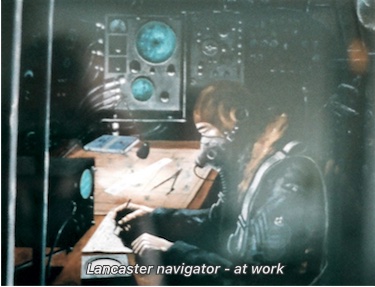
By this time, the weather was appalling. Low cloud almost down to sea level, pouring rain a wind blowing in the region of 40-50 mph and a high sea running. The pump had to be manned all the time, this we did in relays, the remainder baling out with anything they could find. Due to the very low cloud, the air cover had to return to base, and we were alone once more. At the mercy of the North Sea.
An uneasy night was spent by all, and when dawn broke, the rain stopped, the cloud still persisted and the wind seemed to increase and the sea got dangerously rough.
The port gunwale was badly fractured during the dropping operation of the boat, and the heavy seas were taking a heavy toll on the woodwork. I tied together what pieces I could with cord, but that didn’t make very much difference. Unless the sea calmed down, and that was very unlikely, we wouldn’t be able to last out much longer. The boat was actually breaking up underneath us!
At 10:00 hrs three aircraft came back, despite the weather, and more rockets were fired off. Wonderful fellows these A.S.R boys.
It was useless to pump or bale out any more. The waves just poured down on us from all four sides, and in no time the whole boat was awash, and we were sat up to our waists in water clinging on to anything that would hold, just hoping for the best to happen.
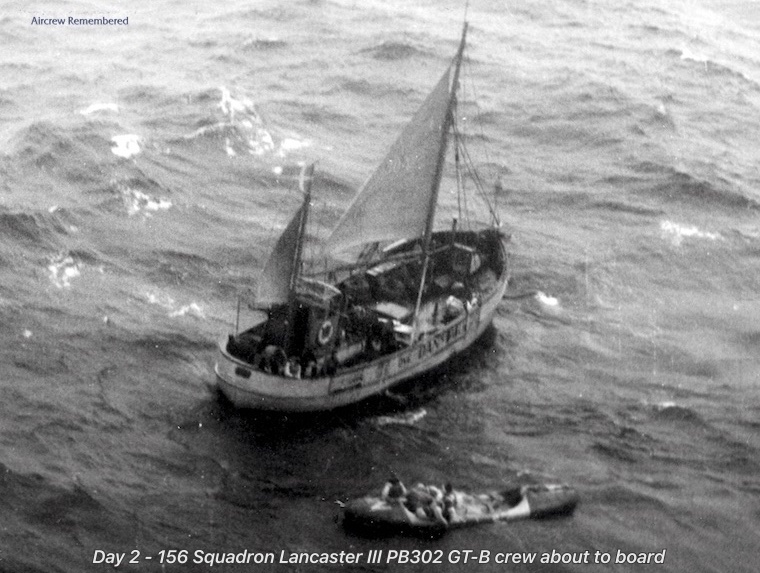

We were all hoping that a rescue launch would come out, but considering the condition of the sea, we ruled out the idea.
More agonising hours passed and then as if from nowhere a sail appeared on the horizon. We popped off what we had left of our distress signals and waved and shouted, and Johnny even tied a garment to the end of an oar and waved that too.
Two of the aircraft were directing the boat towards us, while the third one circled overhead. Finally the boat reached us, and with great difficulty we were all hauled aboard. Bob was almost washed away during the process.
It was a small Danish fishing vessel with a crew of four, and with the aid of signs and broken English, the crew were made to understand who and what we were. At first they wanted to take us back to Denmark, but the idea didn’t really appeal to us, so we mentioned Sweden, but that was out if the question due to mined areas.
At that moment, one of the aircraft dropped a message giving the course to steer for England. The Danes set course eastward. All was well.
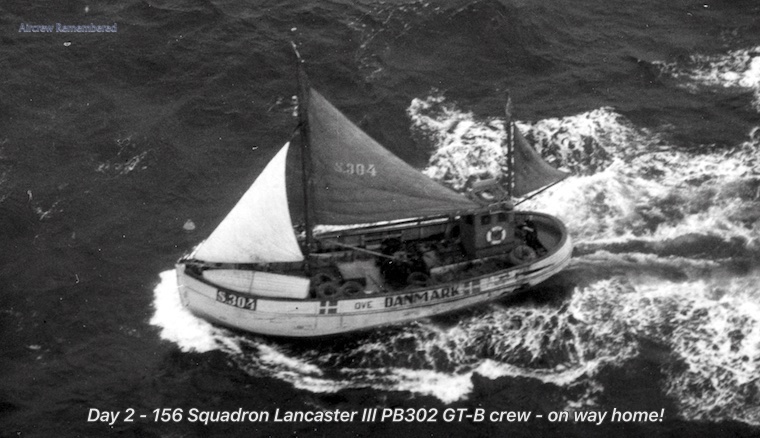
Below decks, the stench of fish was almost unbearable, but it was good to get into a clean pair of trousers and a clean sweater and go to sleep in a solid bunk in spite of the rocking of the boat. Occasionally, one of us would dash up on to the deck to pay his respect for the mermaids.

If the food in Denmark is the same as we had on board, I honestly sympathise with the poor Danes. Tea, bread, butter, canned tongue (gristle) and sardines. But under the circumstances, it was well digested.
Bill switched on the cabin radio and we were just in time to hear Crosby and Tommy Handley. Home felt so near then. Cigarettes were unavailable, but we still had a few from the dingy pack. The Danes enjoyed them too. When the stubs were to small to hold, they put them into their pipes.
During the night, the engines were stopped due to the heavy swell, and we just drifted.
Wednesday morning brought a clear sky, and for the fourth day we had air cover.
Around noon, an air launch was sighted and very soon we were transferred into its warm cabin, clean clothes, hot soup from self-heating tins, and a hearty good meal. At least here was somebody who could peak our own language.
We told the Officer in charge of the shortage of food etc. on the Danish boat, so supplies were thrown over to them. The poor devils just revelled in the food and cigs.

We were all too excited to have a sleep, so we stayed up and talked until around midnight when we sailed into Grimsby. The Navy took over the Danish boat at Spurn Head.
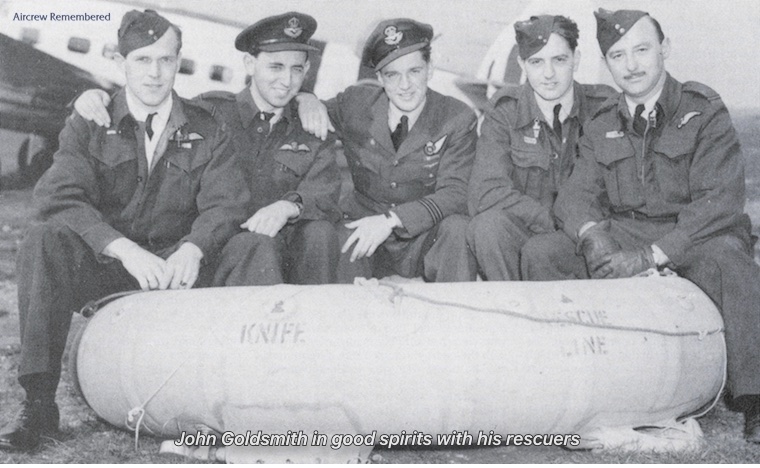
Even the dockside steps were rocking as we walked up them into the naval bus waiting for us. Soon afterwards, we were at the Naval sick Quarters and after a brief medical, a hot meal and a steaming bath, bed ……… beautiful bed! Safe and sound in a beautiful bed!!
Sid Freeden - September 30th 1944.
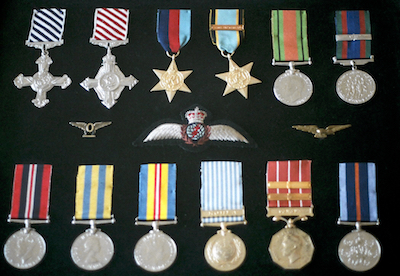
Left: The awards of John Goldsmith, including the DFC and the AFC after retiring as Wing Commander.
Burial details:
None - all crew survived thanks to the remarkable support from the Air Sea Rescue Units and the Danish people.
Researched and dedicated to the relatives of this crew with thanks to Jack Albrecht and the family of P/O. John Goldsmith - illustrated story by Sidney Freeden and to Jenny Stephens his daughter who scanned the pages for Jack. Other sources as quoted below. The two paintings shown (Lancaster preparing to ditch and Navigator at work) are from John Goldsmith's collection.
AWARDS:
Fl/Lt. Robert Mather Etchells DSO. DFC.
Fl/Sgt. John Davidon Gray DFM.
P/O. John E. Goldsmith DFC.
Fl/Lt. Allan James Campbell Croome DFC.
W/O. Evander William Cameron Hay DFC.
Fl/Sgt. John Francis Stearn DFM.
P/O. Sidney Freeden DFC.
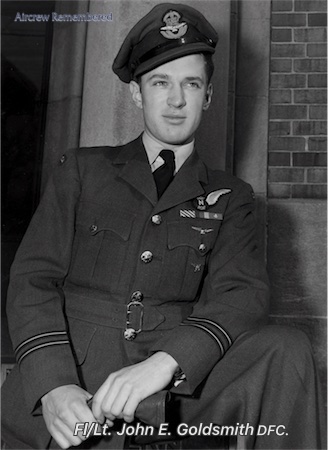
Article submitted on the Danish fishermen was written by John Goldsmith DFC. for the Airforce magazine in 1983.
ABOUT THE AUTHOR:
John Goldsmith enlisted in the Canadian Army early in 1940 and transferred to the RCAF two years later as a navigator. He flew with RAF Bomber Command, Pathfinder Force and RCAF Coastal Command in WWII and with USAF Transport Command in Korea. Later he commanded 425 All Weather Fighter Squadron.
He had the rare distinction as a navigator with the rank of Wing Commander of overseeing two squadrons of CF-100 jet fighters! In 1973 he retired from the forces after 33 years of service and owned and operated a tax consulting business.
John died in Victoria, British Columbia, Canada on November 3, 2010.
The rescuers story
The 27-ton fishing vessel “Ove” was on its last fishing trip in the North Sea before going home and laying over for the winter because of a scarcity of fuel. With lights extinguished, the vessel lay to for the night of 26 Aug 44 at a position 130 nautical miles SW of Denmark. The four crew members, skipper Hans Olsen, mate Karl Jorgensen, fishermen Thomas Thomassen and Poul Jorgensen, all from Skagen, were all on deck cleaning fish. After a good week’s fishing, “Ove” had about 15,000 kilos of plaice in her hold and was soon to begin the trip home to Skagen, a port on the NE coast of Denmark.
“We were all four doing the fish when we heard one formation of English aircraft after another fly over us at low altitude,” related Karl Jorgensen many years later.
“I remember we discussed how we would tell about this when we got home because many of our fishermen friends had reported seeing English planes, but this was quite fantastic and much more than we had heard before.”
“ At day break on the 28th of August we started home from the Clover Banks where we had fished. It was rough weather with a strong breeze which later developed into a storm so we made slow progress. Late in the afternoon three English planes flew over us very low (RAF Air- Sea Rescue Hudsons). We hoisted the Danish flag and waved to them. Soon after, the planes came back and made signs that we should follow them further west. Early in the evening we came upon a battered boat with seven famished English flyers who were taken aboard.”
“Three of our crew had often fished out of Grimsby on the English east coast before the war so we knew a little English. The flyers asked us to take them to Sweden but we decided it would be too dangerous as the chances of being stopped by a German patrol boat and searched were too great. When one of the flyers mentioned England, Skipper Olsen only smiled. If any Danish ship sailed west of this line, German pilots were ordered to shoot at it without warning, and this happened on several occasions. However, a decision was soon reached. While we were negotiating with the English flyers, one of the planes flew over very low and tossed a message container to us. In it was a map with instructions written on it to steer 250 degrees for England - good luck!”
In a broadcast made by the US Armed Forces radio network after the fishermen from Skagen arrived in England, Skipper Olsen told of the meeting with the English flyers.
SEASICK:
“They were a bit seasick but we gave them dry clothes and made them some tea. We also had some tins of pork tongue which they enjoyed when they were over their seasickness. They gave us cigarettes. At home we smoked apple leaves. Over here it is a complete paradise with cigarettes!”
Tuesday, 29 Aug., at 1700 hours, an RAF rescue vessel sailed to meet the rescuers. The flyers went aboard and were set ashore the next morning in Grimsby. A Royal Navy ship took aboard the four fishermen and towed the “Ove” to Grimsby.
“When we got back to the “Ove” the next day, a big net with a catch of plaice was missing.” said Karl Jorgensen, “But we felt it quite in order that the sailors got a little variety in their fare!”
INTERROGATION:
“Two days later we were brought to a camp in London. Every morning for the next six days we were interrogated by a Norwegian security officer. On detailed maps of Skagen we had to identify different places and tell where various people lived. They wanted to be sure we really were fishermen from Skagen and not German agents. Once the English were satisfied about our identity, we could wander freely in London. We were conducted to Denmark House and we spoke with Christmas Moller, the senior Danish representative in England, who thanked us for saving the flyers. We were pleased hear that the Canadian navigator, F/L Goldsmith, had been to Denmark House to find out if we were being cared for.”
“Later, correspondents from the American Forces radio asked us to tell of our adventures in the North Sea. In the broadcast, Thomas Thomassen, talked about London, ‘It is a big place and I find it a bit difficult to find my way around over here. There is a lot of activity in the streets. I noticed that when planes go over, no one reacted on the street. That is different from my home!’ Added Karl Jorgensen, ‘The thing I noticed first was the many women in uniform and the many female drivers!’”
UNAWARE OF FATE:
“From the middle of August until one day in November, Mrs. Jorgensen and others in Skagen were unaware if our fate. On the eighth of September some local people heard a radio broadcast from England describing the rescue of some English flyers and thought we were involved. Mrs. Jorgensen was informed of this by friends but heard nothing official. Early in November she received a Red Cross telegram, finally being told that her husband was safe in England.”
“After we were allowed to move freely in England we hoped soon to go fishing in the ‘Ove’, but this did not happen. Three weeks later we learned we were going to work. It was decided that splicing ropes was what we were best suited for so we were driven to a factory. We looked at each other in some confusion when it turned out to be a sausage factory. Somehow or other there had to be a misunderstanding. But we went to work anyway, along with 17 other Danes. In a short time we made many friends among the 600 workers at Walls Sausages. At Christmas we received good news when we learned that we were to be allowed to start fishing in the ‘Ove’, with the restriction that we must not leave English territorial waters”
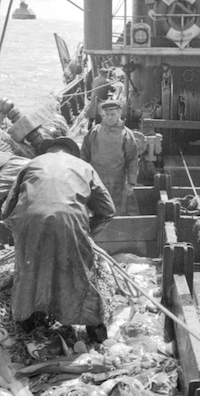 RETURN TO FISHING:
RETURN TO FISHING:
New Year’s, 1945, “Ove” was tied up in Grimsby being readied for a return to fishing. The vessel’s white hull was now painted a dark green and registration changed from S304 to the English fishing fleet number L.O.70. In the meantime, Skipper Olsen had gone to Scotland to work on another fishing vessel. Poul Jorgensen, the youngest crew member at 21, had volunteered for duty in the Royal Navy.
Right: Grimsby, 1944
Late in January, Karl Jorgensen and Thomas Thomassen started fishing with the “Ove” from the port of Whitehaven, on England’s west coast. Previously the pair had been given a course in shooting as the “Ove” was now armed with two machine guns and plenty of ammunition.
Jorgensen and Thomassen were given permission in the spring to fish towards Iceland but had to sign a declaration that they would not return to Skagen earlier than six months after the end of the war with Japan. Many years later, Karl Jorgensen was to relate, “It must now be conceded that we did not stick to our parole and in September 1945 we made a quick visit to Skagen. When we docked in England again we had to make a report explaining why we had sailed around the North Sea for so many days looking for fish!”
They were finally given permission to return home to stay and on 21 Dec 45 they returned to Skagen.
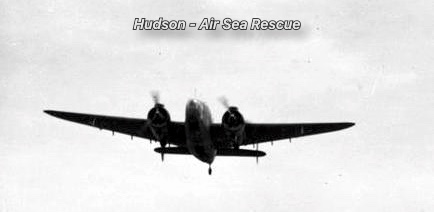
VITAL ROLE:
This story would not be complete without mentioning the vital role played by the RAF Air-Sea Rescue units in this rescue. Not only did the Hudson crews locate us and direct the Danish fishing vessel to our aid, they did this while contending with atrocious weather conditions and the risk of attack by German aircraft which were in the vicinity looking for us. In one eight hour period, the Hudson crews dropped a rubber dinghy and two airborne lifeboats. Because of adverse weather conditions and rough seas it was not until the following night, by miraculous chance , that we drifted into one of the lifeboats. In addition to aircraft, RAF Air-Sea Rescue sent out two rescue ships to assist in the rescue but they were forced to turn back because of weather and mechanical problems.
Their part is best summed up by the terse report submitted by one of the Hudson captains, F/O Nicholson of the RCAF.
“Fl/Lt. Goldsmith was one of a crew rescued after five days and 24 sorties. The weather was extremely bad and many of us landed after sorties with less than 10 minutes flying time left!”
